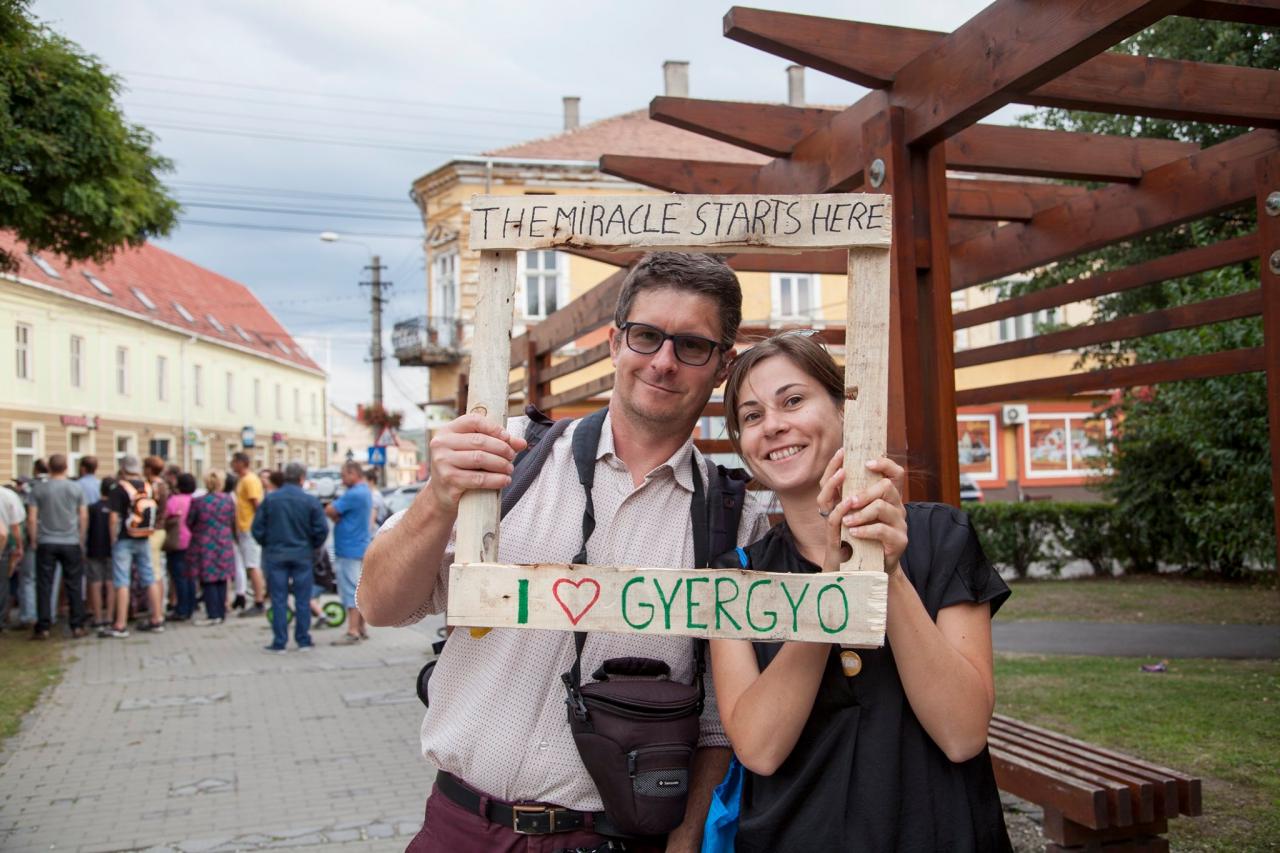
The URBACT Come In Talking Houses/Shared Stories Transfer Network marks a milestone, as the first festivals modeled on the Budapest 100 Open House Weekend were held. In the first part of our series we asked Rita Szerencsés (Hungarian Contemporary Architecture Centre) and Ferenc Szigeti-Böröcz (network expert) about their first experiences.
What is the most important piece of knowledge you wanted to pass on to your partners?
Rita Szerencsés: For the first year of Urbact we aimed to make the partners comfortable with the good practice (and the requirements of the Urbact) itself: the purpose, the methods, principles, the techniques, communication, channels, outputs etc. Also to start to understand their own possibilities, context and obstacles through the lens of the good practice and to encourage them to begin experimenting and learning while acting (action learning method).
Ferenc Szigeti-Böröcz: The Come in! Network is centred around an easily adaptable 2-day long community festival taking place each year in Budapest, called Budapest100, celebrating the city’s built heritage and common values. All of us are excited what and who is there behind the doors of residential buildings. Who lives there now and who has lived there before and what stories they could tell. Thus in theory, and in line with the motto of the festival (i.e. every house is interesting) the good practice can be organised in any residential areas having a specific character and spirit.
But the main aim of the good practice is primarily not to protect buildings, but to encourage civilian power alongside the built environment as a catalyst. Its broad mission is to initiate a common discussion about urban revival and to inspire the establishment and strengthening of residential communities and to take action against urban social isolation by using cultural heritage and built environment as a tool.
Reflecting on the built environment through interesting activities is not so difficult, but tackling the other two key principles of the good practice, proper engagement of communities and volunteers is more challenging, simply because it can be difficult to boost these factors as they are deeply rooted in the socio-economic environment and cultural attitudes of the given country.
After the first pilot transfers, I hope that partners understand that through social innovation they can generate significant policy impact or spill-overs on the long run based on the results of such a community festival.
So far community festivals have been organized in three cities based on the best practices of Budapest 100. What are your first experiences?
Rita Szerencsés: Generally speaking every local organiser had the symptoms of fear, self-doubt, frustration, incapability, miscommunication ect. They raised the bar form themselves so high that they scared to meet their own requirements.
I felt this year is more about the formalities, externalities, objectives like research and organiser team setup and visual appearance (on-site posters, flyers). This is right and suitable for half-way transfer process. The pilot festivals were perfectly handy for practice, internalizing the principles of the good practice and understanding by doing/acting the essences of the transfer. As member of the expert team we will work on helping the cities to fill up the frame with content like: volunteers and locals are fully and truly involved to contribute, there are real actions in the open houses (picnics, games so on), and there are inclusive meaningful urban co-creations involving the locals.
Ferenc Szigeti-Böröcz: The first experience is essential for the partnership. It is great to see that the good practice can be indeed tested in a completely different environment, namely newly built environment at Őrmező (Újbuda). This is already an achievement from the good practice point of view, especially since many partner cities will reflect on modern environment. Addressing the built heritage of the Socialism is a great success, but - in line with the above mentioned - it is also clear that proper engagement of communities and volunteers is more challenging. And although with different extent, these aspects were less visible in the three pilot festivals. Residents and volunteers have not taken the central stage. But this is OK, since the project is about learning, and project partners had a crucial ‘on-the-spot’ experience. The Spanish team made a fantastic performance during the partner meeting in Gheorgheni: they played a role-play about how difficult is to involve residents and convince them to open their doors. It was very funny, but after laughing everyone in the room felt that this is not far from reality. This summed up very well the challenges of the good practice transfer.
Personally, what was your favorite moment?
Rita Szerencsés: In Gyergyó I had two favorite moment. One was related to the good practice transfer, the other one was more about the joint meeting we held in September with all the partners. So during our walk led by Isti Elekes, we visited an empty apartment which used to be the home of the Isti’s grandmother. There was an exhibition non-used property containing old family photos, archive photos of the building and of the interior and even furnitures belonging to the grandmother. The story what the grandson shared with the international audience, was more than touching. He introduced the journey of his grandmother: how she could leave her skeptic feelings behind regarding the sense of the good practice and seeing the visitors, curious locals and citizens she started to be emotionally proud of her own heritage. Listening to this story I felt this is the reason why we believe in the method and the necessity of the urban storytelling. The another moment I would like to mention is the participatory planning workshop on the main square at Gyergyó where the representatives of the partner cities could set a good example how participatory methods can add some spark to huge rehabilitation processes.
Related to Őrmező it worth to mention the short guide by the administrator of the local facebook group, who gave some hint about the exhibited photos and stories shared in the the online platform. Also he was the one, who recorded and live streamed every single moment of the afternoon just to capture the spirit and share it with those who missed the first edition.
In Plasencia my general and overall favourite was the enthusiastic behaviour of the local organisers. A very dedicated team tried their best to comfort the international partners and provide a meaningful transfer pilot for the city. I loved to meet the local storyteller gentleman, who knew everything about his building + neighbourhood and also he is the heart of a local NGO helping people with mental difficulties.
Ferenc Szigeti-Böröcz: I visited the festivals in Újbuda and Gheorgheni. Transylvania is a symbol of lost and hidden heritage, and actually the town’s Armenian heritage is indeed very unique. In one of the open houses it was possible to read about some traditional Armenian food, and it was even possible to taste some of them. Food is a secret power, you know, it can knit together people and build communities. And in that courtyard visitors and locals could enjoy something you cannot find in books. It was simply amazing, a real treasure-hunting. I also really liked in Gheorgheni that partners actually contributed to the festival by organising small-scale placemaking actions on the main square. Partners understood that it is not possible to create communities without doing something together.
At Őrmező I really liked the discussion with professionals. I have a secret goal within the project, namely I believe that within the Come in! – Talking Houses / Shared Stories network we can pave the way for and contribute to the revalorisation of dissonant or brutal heritage just as the prefabricated housing estates built during the Socialism and initiate a professional discussion on it. It was a very first step, but a step going ahead.

